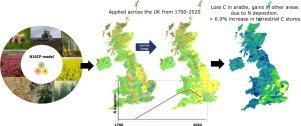Anthropocene ( IF 3.6 ) Pub Date : 2021-03-26 , DOI: 10.1016/j.ancene.2021.100289 Victoria Janes-Bassett , Richard Bassett , Ed C. Rowe , Edward Tipping , Dmitry Yumashev , Jessica Davies

|
Carbon stores in the terrestrial biosphere globally represent over 50 % of present-day organic carbon reservoirs and have significantly altered over the last three centuries owing to anthropogenic disturbances. Conversion of natural land to agricultural uses often results in a loss of soil carbon, whilst atmospheric deposition of pollutants such as nitrogen has increased carbon storage in both soil and biomass. Terrestrial carbon storage underpins a range of ecosystem services, including climate regulation, food production, and water services. This storage is crucial for sustainable land management. Quantification of terrestrial carbon cycling at regional and national scales, and understanding how human-induced drivers have impacted present-day carbon stores is therefore required to inform sustainable land use policy. This study applies the N14CP model, an integrated soil-plant biogeochemistry carbon-nitrogen-phosphorus model, across the United Kingdom to simulate changes in terrestrial carbon storage from 1700 to 2020. The analysis shows that change in anthropogenic terrestrial carbon storage is a complex picture comprising of gains in natural areas due to nitrogen deposition and afforestation, and losses in arable areas. We observed an overall net increase in total terrestrial carbon storage of 6.9 %. We note, however, that continued increases in carbon storage cannot be assumed due to (i) reduced influence of future nitrogen deposition as these systems become limited by other nutrients, (ii) the need to continue enhanced nitrogen inputs to maintain carbon sequestered, and (iii) carbon declines in arable areas continuing alongside diminishing gains in other land use types. This research provides a full picture of anthropogenic impacts on terrestrial organic carbon storage, accounting for changing nutrient cycles at a national scale.
中文翻译:

前工业化时代以来碳储存的变化:国家规模分析
全球陆地生物圈中的碳储量占当今有机碳储量的50%以上,并且由于人为干扰而在过去三个世纪中发生了显着变化。将自然土地转化为农业用途通常会导致土壤碳损失,而大气中诸如氮等污染物的沉积增加了土壤和生物量中的碳储量。陆地碳储存是一系列生态系统服务的基础,包括气候调节,粮食生产和水服务。该存储对于可持续土地管理至关重要。因此,需要量化区域和国家范围内的陆地碳循环,并了解人为驱动因素如何影响当今的碳储量,以为可持续土地使用政策提供依据。这项研究应用了整个英国的N14CP模型(一种整合的土壤-植物生物地球化学碳-氮-磷模型)来模拟1700年至2020年期间陆地碳储量的变化。分析表明,人为陆地碳储量的变化是一个复杂的图景包括由于氮素沉积和植树造林而在自然地区获得的收益,以及在耕地方面的损失。我们观察到陆地总碳储量总体净增加了6.9%。但是,我们注意到,由于以下原因,不能假设碳储存量会持续增加:(i)由于这些系统受到其他养分的限制,未来氮沉积的影响减小;(ii)需要继续增加氮的输入量以保持碳固存,(iii)耕地的碳排放量继续下降,而其他土地利用类型的收益却在减少。这项研究全面说明了人为因素对陆地有机碳储量的影响,这说明了全国范围内养分循环的变化。



























 京公网安备 11010802027423号
京公网安备 11010802027423号